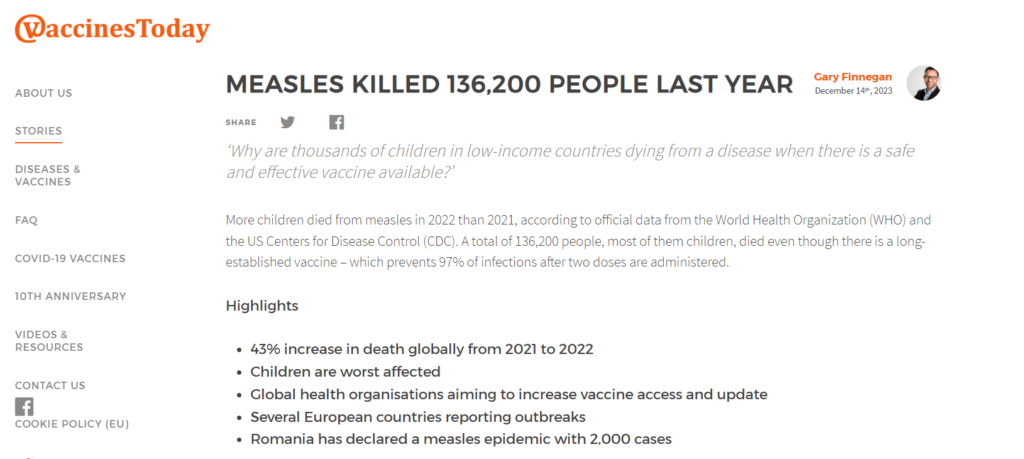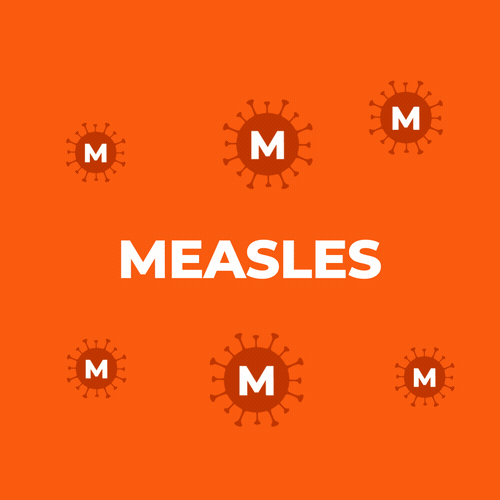the health strategist
platform
the most compreehensive knowledge portal
for continuous health transformation
and digital health- for all
Joaquim Cardoso MSc.
Chief Research and Strategy Officer (CRSO),
Chief Editor and Senior Advisor
December 15, 2023
What is the message?
The article by Gary Finnegan underscores the alarming rise in measles-related deaths, with 136,200 fatalities in 2022, emphasizing the pressing need for global action to combat the resurgence of the preventable disease.
Despite the availability of a safe and effective vaccine, the increase in cases and deaths, particularly among children, prompts a critical examination of vaccination strategies and a call for renewed efforts to achieve widespread immunity.

One page summary
What are the key points?
- Rising Measles Deaths: Official data from the World Health Organization (WHO) and the US Centers for Disease Control (CDC) reveal a 43% increase in global measles deaths from 2021 to 2022, with children being the most affected demographic.
- Global Outbreaks and Vaccination Challenges: The number of measles cases rose from 7 million in 2021 to 9 million in 2022, attributed to a decline in routine vaccination rates during the pandemic. Large or disruptive outbreaks affected 37 countries, emphasizing the challenge in achieving herd immunity, especially in low-income countries with low vaccine uptake.
- Measles Contagion and Symptoms: Measles is highlighted as one of the most contagious viruses, spreading easily and infecting multiple individuals when one person is affected. The article outlines the symptoms, transmission, and worrying trends associated with the virus.
- Concerns in Europe: Despite efforts to eliminate measles, setbacks in Europe are noted, with low vaccination rates in several countries, including Montenegro, the Balkans, and parts of the UK, Ireland, Belgium, Austria, Slovenia, Romania, and the Netherlands.
What are the key strategies?
- Global Vaccination Programs: The Measles & Rubella Partnership’s work since 2001 has aimed to vaccinate millions of children globally, preventing an estimated 57 million deaths. A renewed commitment to measles vaccine programs and reaching zero-dose children is emphasized.
- Addressing Pandemic Disruptions: Acknowledging the impact of pandemic-related disruptions on immunization rates, the call is made to ensure health systems are equipped to reach even the hardest-to-reach communities and recover from the decline in vaccination coverage.
What are the key examples?
- Tajikistan Outbreak: A major measles outbreak in Tajikistan is highlighted, with efforts from UNICEF and the World Bank to deliver 2.5 million doses of measles vaccine.
- Continued Concerns in Europe: Persistent concerns about low vaccination rates in the Balkans and specific European countries, despite catch-up campaigns and progress, are pointed out.
Conclusion
The article concludes with a call to action, emphasizing the need for sustained attention on recovering from the pandemic and ensuring health systems are equipped to reach all communities.
The surge in measles outbreaks and mortality serves as a stark reminder of the importance of global collaboration to protect children worldwide through effective vaccination strategies.
DEEP DIVE

MEASLES KILLED 136,200 PEOPLE LAST YEAR
VaccinesToday
Gary Finnegan
‘Why are thousands of children in low-income countries dying from a disease when there is a safe and effective vaccine available?’
More children died from measles in 2022 than 2021, according to official data from the World Health Organization (WHO) and the US Centers for Disease Control (CDC). A total of 136,200 people, most of them children, died even though there is a long-established vaccine ‒ which prevents 97% of infections after two doses are administered.
Highlights
- 43% increase in death globally from 2021 to 2022
- Children are worst affected
- Global health organisations aiming to increase vaccine access and update
- Several European countries reporting outbreaks
- Romania has declared a measles epidemic with 2,000 cases

The number of cases globally also rose significantly, from 7 million in 2021 to 9 million in 2022. Experts attribute this to a dip in routine vaccination rates during the pandemic. In 2022, 37 countries were affected by large or disruptive measles outbreaks, nearly double the number of countries in 2021. The risk of dying is highest in low-income countries where vaccine uptake is lowest.
When uptake of two doses of measles vaccine reaches 95%, the virus stops spreading in the community as there are too few unprotected people to infect. This is called herd immunity.
‘A 43% increase in measles deaths, mostly among children, is a devastating reminder of what is at stake when we don’t vaccinate communities against deadly diseases,’ said Dr Ephrem Lemango, UNICEF Chief of Immunization. ‘We know what it will take to fill the immunity gap and recover from the decline in immunisation coverage, and we know what it will cost. The next step is to act.’
A global push to drive down the number of cases and deaths has been under way for decades. Since 2001, the Measles & Rubella Partnership has worked with countries to vaccinate millions of children, helping to prevent an estimated 57 million deaths.
WHY IS MEASLES SO DIFFICULT TO ELIMINATE?
Measles is one of the most contagious viruses in circulation, spreading far more easily than COVID-19, for example. When one person is infected with measles, they can pass the virus on to between 16 and 18 others ‒ unless those around them are immune following prior infection or vaccination.

Measles symptoms usually appear after 10-12 days of infection, meaning that a child could feel fine and continue attending school and society activities where they may pass the virus to others.
Initial symptoms resemble a cold with a runny nose, cough and a mild fever, according to the European Centre for Disease Prevention & Control (ECDC). The eyes can become red and sensitive to light; on the third to seventh day of symptoms, the temperature may reach up to 41 ⁰C. A red rash lasting four to seven days begins on the face and then spreads over the entire body; small white spots may also appear on the gums and the inside of the cheeks.
WORRYING TRENDS
In Europe, the WHO has been coordinating efforts to eliminate measles since 2011. Despite long-term progress, there have been setbacks along the way, with outbreaks occurring where vaccine uptake is lowest. Pandemic-related disruption saw infant immunisation rates fall, but catch-up campaigns have ensured that most parents in Europe have had access to recommended vaccinations for their children.
The WHO’s Regional Office for Europe has recorded a major measles outbreak in Tajikistan, where UNICEF and the World Bank delivered 2.5 million doses of measles vaccine this summer.
WHO experts have also expressed concern about low measles vaccine uptake in the Balkans. In particular, vaccination rates in Montenegro in the period from 2019-2021 fell below 20%. However, there has been some progress since then, according to the WHO Regional Verification Commission on Measles & Rubella Elimination.
There are also ongoing concerns about low vaccination rates in parts of the UK, Ireland, Belgium, Austria, Slovenia, Romania, the Netherlands and elsewhere. In all countries, there are communities within which vaccine uptake is extremely low, increasing the risk of an outbreak.

STEPPING UP ACTION
Aurélia Nguyen, Chief Programme Officer at Gavi, the Vaccine Alliance, said the organisation would ‘double down on its commitment’ to measles vaccine programmes and reaching zero-dose children in 2024. ‘The concerning surge in measles outbreaks and mortality is a stark reminder of the importance of sustained attention on recovering from the pandemic and ensuring health systems are equipped to reach even the hardest to reach communities.’
An estimated 25 million children received no vaccines in 2021, with global immunisation rates suffering the worst decline in 30 years. This exacerbated global health inequalities, with those in the poorest countries hit the hardest.
‘The lack of recovery in measles vaccine coverage in low-income countries following the pandemic is an alarm bell for action. Measles is called the inequity virus for good reason. It is the disease that will find and attack those who aren’t protected,’ said Kate O’Brien, WHO Director for Immunization, Vaccines and Biologicals. ‘Children everywhere have the right to be protected by the lifesaving measles vaccine, no matter where they live.’
Originally published by https://www.vaccinestoday.eu











